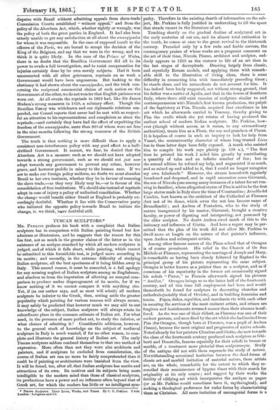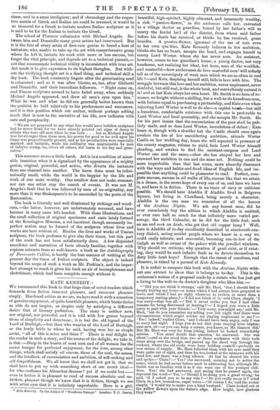TUSCAN SCULPTORS.*
MR. PERKINS prefaces his book with a complaint that Italian sculpture has in comparison with Italian painting found but few admirers or illustrators, and he suggests that the reason for this lies first, not so much in the greater claims of the latter as in the existence of an antique standard by which all modern sculpture is judged, and of which it falls short, while painting, which cannot be submitted to this formidable test, is judged more according to its merits ; and secondly, in the extreme difficulty of studying Italian sculpture, all the best specimens of it being hidden away in Italy.. This second reason, it must be conceded, is a full apology for any seeming neglect of Italian sculpture among us Englishmen, and absolves us from the imputation of allowing an unequal com- parison to produce undue disparagement of its merits, for if we know nothing of it we cannot compare it with anything else. Yet, if (as our author says, and as most will admit) all modern sculpture be inferior to the Greek, then, setting aside the greater popularity which painting for various reasons will always secure, it may safely be predicted that however much we may add to our knowledge of the subject, Italian sculpture will always retain its subordinate place in the common estimate of Italian art. For what need, in the presence of more perfect art, to study the inferior, or what chance of admiring it? Considerable additions, however, to the general stock of knowledge on the subject of mediaeval sculpture in Italy is much wanted, if for no other reason, to com- plete and illustrate the general history of Italian art. The early Tuscan sculptors seldom confined themselves to that one method of expression. More often than not they were also architects and painters, and if sculpture be excluded from consideration, the course of Italian art can no more be fairly comprehended than it could be if painting or architecture were banished from the view. It will be found, too, after all, that Italian sculpture has merits and attractions of its own. Its motives and its subjects being more intelligible to the modern mind than those of classical sculpture, its productions have a power and an influence often beyond that of Greek art, for which the modern has little or no intelligent sym- • Tuscan Sculptors. Their Lives, Works, and Tames. By C. C. Perkins. 2 rola. London : Longman and Co.
pathy. Therefore in the existing dearth of information on the sub- ject, Mr. Perkins is fully justified in undertaking to fill the space that stands vacant in the literature of art.
Touching shortly on the gradual decline of sculptural art in the early centuries of our era, and its almost total extinction in the tenth, he comes at once to the great revival in the thirteenth century. Preceded only by a few rude and feeble carvers, the contemporary praises of whose works are a pregnant comment on the art of their time, Niccola Pisano, architect and sculptor, sud- denly appears in 1260 as the restorer to life of an art then in the last stages of decrepitude. Drawing largely from classic, and especially Roman models, and applying them with remark- able skill to the illustration of living ideas, there is some difficulty in connecting him with immediately preceding times ; he stands alone, and his antecedents do not account for him. It has indeed been lately suggested, not without strong ground, that his father was a native of Apulia, and that in the towns of Southern Italy, where there still exist remains of sculpture similar to and contemporaneous with Niccola's first known production, the pulpit of the baptistery at Pisa, Niccola acquired that excellence in his art which he afterwards carried to 'Tuscany, thereby giving to Pisa the credit which she yet retains of having produced the earliest school of modern Italian sculpture. Mr. Perkins, how- ever (though without access, as it seems, to any extraordinary authorities), treats him as a Pisan, the son and grandson of Pisans. It is hopeless of course in such an inquiry to look for help from Vasari, the untrustworthy character of whose long-trusted Lives has in these latter days been fully exposed. A monk who assisted him to compile his work says plainly (p. 138 n.), " The first time he printed his work I aided him greatly by contributing a quantity of tales and an infinite number of lies ; but in the second edition he refused my help, and augmented it so much, and so mixed up and added to it, that I could no longer recognize my own falsehoods." However, the stream henceforth regularly broadened and deepened, and in rapid succession come Giovanni, the son of Niccola (one among many instances of a talent for art run- ning in families), whose allegorical statue of Pisa is said to be the first large statue made in Italy since the time of Constantine; Arnolfo del Cambio, best known as the architect of the Cathedral at Florence (but not of its dome, which owns the not less famous name of Brunelleschi) ; and Andrea of Pontedera, who to the study of nature inaugurated by his master, Giovanni, brought a creative faculty, or power of digesting and interpreting, not possessed by the elder sculptor. No doubt Andrea owed much of this to the intimacy and influence of Giotto. And here a regret may be per- mitted that the plan of his work did not allow Mr. Perkins to dwell more at length on the nature of that painter's influence, upon Andrea and subsequent artists, Among other famous names of the Pisan school that of Orcagna is of course prominent. His relief in the Church of Or San Michele at Florence, representing the marriage of Joseph and Mary, is remarkable as having been closely followed by Raphael in the principal group of his picture representing the same subject. Orcagna is better known as a painter than as a sculptor, and as if conscious of his superiority in the former art occasionally signed his reliefs " Pictor," as Francis afterwards signed his pictures " Aurifex." Orcagna brings us to the latter half of the fourteenth century, and all this time full employment had been and would thenceforth be found for sculptors in decorating churches and cathedrals (notably that of Orvieto), and in building fountains and tombs. Popes, dukes, republics, and merchants vie with each other in securing the services of the most eminent artists, and crimes are forgiven and banishments reversed sooner than their absence is suf- fered. As she was one of their richest, so Florence was one of their earliest patrons, and soon fired by the art which she had invited from Pisa (for Orcagna, though born at Florence, was a pupil of Andrea Pisano), became the most original and progressive of native schools.
Noted already for her painters Cimabue and Giotto, she now towards the close of the fourteenth century produced such sculptors as Ghi- berti and Donatello, famous especially for their reliefs in bronze or marble, of a treatment more pictorial than sculpturesque. Study of the antique did not with them supersede the study of nature. Notwithstanding occasional hesitation between the dead forms of classic art and morbid imitation of material nature, these artists are, on the whole, remarkable for the extent to which they re- conciled their reminiscence of bygone times with their search for originality at its only source ; and suggest by their works the futility of vilifying art which incorporates the antique as pagan
(or as Mr. Perkins would sometimes have it, mythological), and seeking a theological preference for ruder forms by characterizing them as Christian. All mere imitation of uncongenial forms is a
sham, and in a sense irreligious ; and if chronology and the respec- tive merits of Greek and Italian art could be reversed, it would be as immoral for a Greek to imitate modern Italian sculpture as it is said to be for the Italian to imitate the Greek.
The school of Florence culminates with Michael Angelo. Be- tween him and Donatello many great artists had intervened. But
it is the fate of every artist of first-rate genius to breed a host of imitators, who, unable to take up the art with comprehensive grasp where he left it, imitate his work with more or less success, but forget the vital principle, and degrade art to a technical pursuit,—
not that consummate technical ability is inconsistent with true art. Art needs it to give expression to its highest thoughts. But with- out the vivifying thought art is a dead thing, and technical skill a dry husk. The husk commonly lingers after the germinating seed is exhausted ; and so it was after Giotto, so, too, after Ghiberti and Donatello, and their immediate followers. " Night came on, and Tuscan sculpture seemed to have faded away, when suddenly Michael Angelo appeared, and drew all men's eyes upon him."
What he was and what he did are generally better known than the position he held relatively to his predecessors and successors, and it is this position which our author, without perhaps adding much that is new to the narrative of his life, now indicates with care and perspicacity.
" We are not prepared to say what fate would have befallen sculpture had he never lived, for we have already pointed out signs of decay in artists who were old men when he was born . . . but as Michael Angelo was far stronger than these men, his power for good or for evil upon his times was proportionably greater and as his peculiarities were especially marked and imitable, while his sublimity was unattainable by men of inferior stamp, ho, above all others, did harm in his day and gene- ration."
This sentence seems a little harsh. Art is in a condition of miser- able inanition when it is signalized by the appearance of a mighty genius, original, powerful, and active, who diverts the imitators
from one channel into another. The harm done must be infini- tesimally small, while the world is the happier by the life and work of one more worthy. One swallow does not make summer, nor can one artist stay the march of events. It was not M. Angelo's fault that he was followed by men of no originality, any
more than it was Shakespeare's to be succeeded by the poets of the Restoration.
The book is liberally and well illustrated by etchings and wood- cuts,—the latter, however, are unfortunately reversed, and have become in many cases left-handed. With these illustrations, and the small collection of original specimens and casts lately formed at the Kensington Museum, a not incorrect though necessarily im- perfect notion may be formed of the sculptors whose lives and works are here written of. Besides the lives and works of Tuscan sculptors, the book professes to give also their times, but this part of the work has not been satisfactorily done. A few disjointed
anecdotes and narratives of facts already familiar, together with copious extracts from so well-known a book as the Autobiography of Benvenuto Cellini, is hardly the best manner of writing at the present day the times of Italian sculptors. The object is indeed
beyond the scope of such a work as Mr. Perkins's, and the imper- fect attempt to reach it gives his book an air of incompleteness and sketchiness, which had been complete enough without it.































 Previous page
Previous page